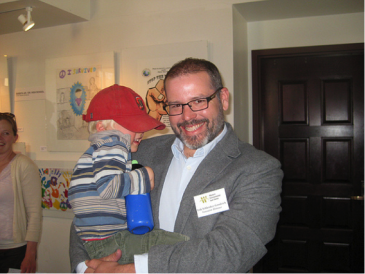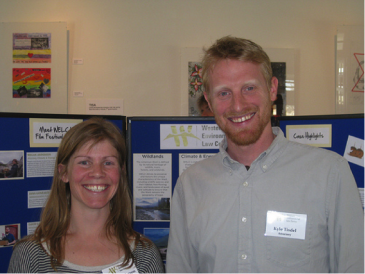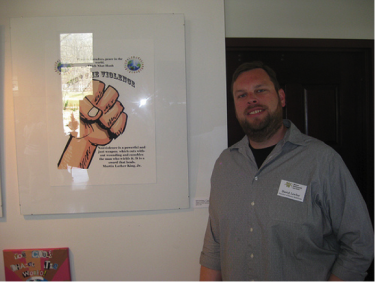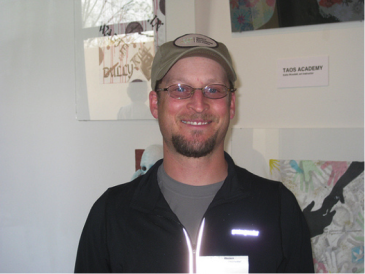

Formed in 1993 in Eugene, Oregon, WELC’s states its mission as: “The Western Environmental Law Center uses the power of the law to defend and protect the American West’s treasured landscapes, iconic wildlife and rural communities . . . . WELC has a highly experienced team of attorneys, conservation biologists and Western policy experts. We work close to the ground, with offices in Oregon, Montana, and New Mexico. As a public interest law firm, WELC does not charge clients and partners for services, but relies instead on charitable gifts from individuals, families, and foundations to accomplish our mission.” The festival’s evening program was hosted by Executive Director Eric Schlenker-Goodrich, who introduced the films, thanked sponsors, and spoke about WELC’s mission and programs.
The first film, Sand Rider, was fun and fast: Colorado native and snowboarder Marc Pastore surfs the sand dunes at Great Sand Dunes National Park and Preserve not far from Taos, New Mexico. The park is nestled at the base of the spine of the Rockies in the Sangre de Cristo Mountains and, though dry, it is still home to elk, bison and reptiles. If you live in the high desert, as we do here, this is one way to get some surfing in without making the long trek to the nearest ocean.

The Return is a 16-minute film produced by High Plains Films about moving a genetically-pure bison herd from Yellowstone to Fort Peck, home to 6,800 Assiniboine and Sioux in northeastern Montana. By 1881, all the buffalo were gone from this region, so the story of the bison’s return is not only one about rewilding bison but also a story about revivifying the Native American cultures connected with the buffalo. The Assiniboine and Gros Ventre tribes at the Fort Belknap Indian Reservation also will receive a portion of this herd. This film is a sequel to the film Facing the Storm, reviewed by Leon Aliski for Izilwane—Voices for Biodiversity.
The next film, Eyes in the Forest: The Portraiture of Jim Lawrence, was one of my favorites. In this film, Miriam Needoba follows photographer Jim Lawrence on his daily rounds while he takes photographs in the Selkirk Mountains of British Columbia. The film had exquisite footage of wildlife and scenery and captured the photographer’s small moments of connection and peacefulness in nature and his concern that we are losing so much biodiversity. If we could value this type of connection — caught so beautifully in this film — we as humans could transform our way of being, question our current assumptions and lifestyles, and move into a more coherent pattern of coexistence with the natural world and the other species who inhabit it.

The next film was Last Light, a radical adventure film by Nick Waggoner and Ben Surgelewski about skiing during the long spring hours in Haines, Alaska. Presented by Patagonia, this film features Stephan Drake, Forrest Shearer, and Johan Jonsson, who are dropped off by helicopter, set up camp, and then hike high and drop fast, making crazy runs that left the
audience moaning with fear and tingling with excitement. Taos being a ski town, this superbly-shot film was a hit.
Next, Stories of Trust: Calling for Climate Recovery, Oregon follows 16-year-old Kelsey Cascadia Rose Juliana of Eugene as she discusses how climate change is affecting Oregon: causing droughts, reducing snow pack, leading to warmer temperatures, causing forest fires. After being assigned a passion project and choosing polar bears, Kelsey became extremely concerned about climate change and became part of the Trust Campaign. According to the Our Children’s Trust website: “The ATMOSPHERIC TRUST Legal Effort, coordinated and supported by Our Children’s Trust, is grounded in the Public Trust Doctrine, which states that it is the duty of the government to protect the resources that are essential for our collective survival and prosperity. These resources — rivers, groundwater, the seashore and in this case, the atmosphere — cannot be privatized or substantially impaired because they belong to everyone equally, even to those not yet born.” Our Children’s Trust, Witness.org, the iMatter Campaign, and students from Montana State University’s MFA in Science and Natural History Filmmaking created a series of ten films featuring nine young people and their stories about climate change. They live in California, Montana, Alaska, Arizona, Iowa, Colorado, Pennsylvania, Oregon and Massachusetts, but their concerns are global. Taos’ own Sean Solowiej was involved in making these films and now teaches at University of New Mexico-Taos and also runs MediaTaos.org.

As always, the Wild & Scenic Film Festival’s annual show in Taos was fun and educational. I look forward to attending again next year.
Photos courtesy of Dr. Tara Waters Lumpkin